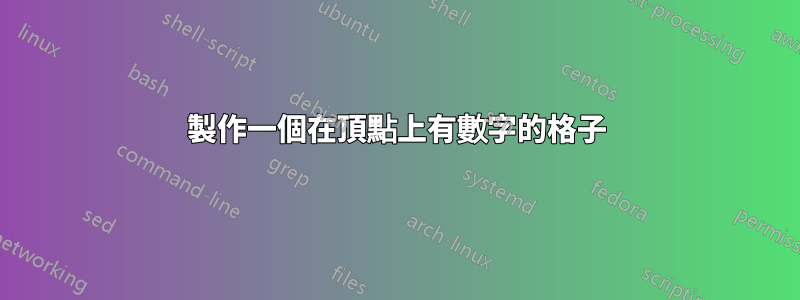
任何熟悉計算矩形中從左下角到右上角的向上/向右路徑問題的人都知道,這樣做的一種方法是透過遞歸來完成。我想將其視覺化,因此我需要製作一個在其頂點上有數字的格子。在下面的矩陣中,數字在正方形內,但我希望它們在頂點上,或者更好的是在四條線的交點上有一個間隙,數字可以在該間隙中。
$\begin{array}{*{20}{c}}
\hline
| & 1&| & 1&| & 1&| & 1&| & 1&| & 1&| & 1| & \\
\hline
| & 7&| & 6&| & 5&| & 4&| & 3&| & 2&| & 1| & \\
\hline
| & {28}&| & {21}&| & {15}&| & {10}&| & 6&| & 3&| & 1| & \\
\hline
| & {84}&| & {56}&| & {35}&| & {20}&| & {10}&| & 4&| & 1| & \\
\hline
\end{array}$
像這樣的東西:

重要提示:在正確答案中的圖像回答問題後,圖像已被編輯。
答案1
這是一種方法:

代碼:
\documentclass{article}
\usepackage{xstring}
\usepackage{tikz}
\usepackage{collcell}
\newcommand{\MakeBox}[1]{\makebox[2.0em][c]{#1}}%
\newcommand*{\MyBox}[1]{%
\phantom{\MakeBox{#1}}%
\IfStrEq{#1}{}{}{%
\begin{tikzpicture}[overlay, draw=red, line width=1.0pt, text=blue]
\node [draw=none, inner sep=2pt] (Node) {\MakeBox{#1}};
\draw (Node.north) -- ([yshift=2.0ex]Node.north);
\draw (Node.south) -- ([yshift=-2.0ex]Node.south);
\draw (Node.west) -- ([xshift=-1.0em]Node.west);
\draw (Node.east) -- ([xshift=1.0em]Node.east);
\end{tikzpicture}%
}%
}
\newcolumntype{C}{>{\collectcell\MyBox}c<{\endcollectcell}}
\begin{document}
$\begin{array}{*{20}{C}}
& 1 & 1 & 1 & 1 & 1 & 1 & 1 & \\[2.0ex]
& 7 & 6 & 5 & 4 & 3 & 2 & 1 & \\[2.0ex]
& 28 & 21 & 15 & 10 & 6 & 3 & 1 & \\[2.0ex]
& 84 & 56 & 35 & 20 & 10 & 4 & 1 & \\ [2.0ex]
\end{array}$
\end{document}
如果您想抑制外部行,則需要透過呼叫 來指示最後一行\ThisIsLastRow。第一列的檢測是透過使用F列類型來處理的。

進一步增強
- 由於我使用 a
\makebox[2.0em][c]{#1}來放置文字以使其保持居中,因此只有單寬度字元的最後一列看起來是錯誤的。解決此問題的一種方法是定義兩種列類型:一種用於兩位數,一種用於單位數。或者,可以在文字中繪製線條,然後將節點文字覆蓋在其上,然後刪除數字周圍的線條。
代碼:
\documentclass{article}
\usepackage{xstring}
\usepackage{etoolbox}
\usepackage{tikz}
\usepackage{collcell}
\newtoggle{IsFirstColumn}\togglefalse{IsFirstColumn}%%
\newtoggle{IsLastRow}\togglefalse{IsLastRow}%
\newcommand{\ThisIsLastRow}{\global\toggletrue{IsLastRow}}%
\newcommand{\MakeBox}[1]{\makebox[2.0em][c]{#1}}%
\newcommand*{\MyBox}[1]{%
\phantom{\MakeBox{#1}}%
\IfStrEq{#1}{}{}{%
\begin{tikzpicture}[overlay, draw=red, line width=1.0pt, text=blue]
\node [draw=none, inner sep=2pt] (Node) {\MakeBox{#1}};
\iftoggle{IsLastRow}{}{%
\draw (Node.south) -- ([yshift=-2.0ex]Node.south);
}%
\iftoggle{IsFirstColumn}{}{%
\draw (Node.west) -- ([xshift=-1.0em]Node.west);
}%
\end{tikzpicture}%
}%
}
\newcommand*{\MyBoxFirstColumn}[1]{%
\global\toggletrue{IsFirstColumn}%
\MyBox{#1}%
\global\togglefalse{IsFirstColumn}%
}%
\newcolumntype{C}{>{\collectcell\MyBox}c<{\endcollectcell}}
\newcolumntype{F}{>{\collectcell\MyBoxFirstColumn}c<{\endcollectcell}}
\begin{document}
$\begin{array}{F*{20}{C}}
1 & 1 & 1 & 1 & 1 & 1 & 1 \\[2.0ex]
7 & 6 & 5 & 4 & 3 & 2 & 1 \\[2.0ex]
28 & 21 & 15 & 10 & 6 & 3 & 1 \\[2.0ex] \ThisIsLastRow
84 & 56 & 35 & 20 & 10 & 4 & 1 \\
\end{array}$
\end{document}
答案2
鑑於您想要的輸出,我想我會使用matrix of nodes

完整程式碼
% arara: pdflatex
% !arara: indent: {overwrite: true}
\documentclass{standalone}
\usepackage{tikz}
\usetikzlibrary{matrix}
\begin{document}
\begin{tikzpicture}[thick]
\matrix (mylattice)[
matrix of nodes,
row sep=.5cm,
column sep=.5cm,
nodes in empty cells,
execute at empty cell={\node[draw=none]{\phantom{X}};},
]{
& & & & & & & &\\
& 1 & 1 & 1 & 1 & 1 & 1 & 1 & \\
& 7 & 6 & 5 & 4 & 3 & 2 & 1 & \\
& 28 & 21 & 15 & 10 & 6 & 3 & 1 & \\
& 84 & 56 & 35 & 20 & 10 & 4 & 1 & \\
& & & & & & & & \\
};
\foreach \i [evaluate=\i as \y using int(\i+1)] in {1,...,5}
{
\foreach \j [evaluate=\j as \x using int(\j+1)]in {1,...,8}
{
\ifnum\j>1
\draw[red] (mylattice-\i-\j)--(mylattice-\y-\j);
\fi
\ifnum\i>1
\draw[blue] (mylattice-\i-\j)--(mylattice-\i-\x);
\fi
}
}
\end{tikzpicture}
\end{document}
根據註釋,如果您不需要外部零件,則可以使用以下稍加修改的程式碼。

% arara: pdflatex
% !arara: indent: {overwrite: true}
\documentclass{standalone}
\usepackage{tikz}
\usetikzlibrary{matrix}
\begin{document}
\begin{tikzpicture}[thick]
\matrix (mylattice)[
matrix of nodes,
row sep=.5cm,
column sep=.5cm,
nodes in empty cells,
execute at empty cell={\node[draw=none]{\phantom{X}};},
]{
1 & 1 & 1 & 1 & 1 & 1 & 1 \\
7 & 6 & 5 & 4 & 3 & 2 & 1 \\
28 & 21 & 15 & 10 & 6 & 3 & 1 \\
84 & 56 & 35 & 20 & 10 & 4 & 1 \\
};
\foreach \i [evaluate=\i as \y using int(\i+1)] in {1,...,4}
{
\foreach \j [evaluate=\j as \x using int(\j+1)]in {1,...,7}
{
\ifnum\i<4
\draw[red] (mylattice-\i-\j)--(mylattice-\y-\j);
\fi
\ifnum\j<7
\draw[blue] (mylattice-\i-\j)--(mylattice-\i-\x);
\fi
}
}
\end{tikzpicture}
\end{document}


